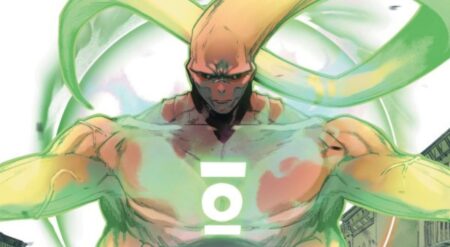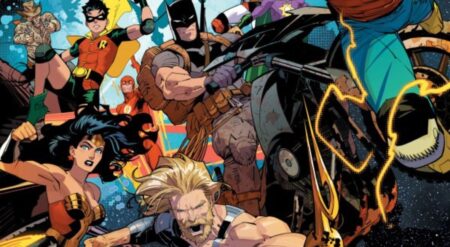
Harley Quinn: Breaking Glass is an original graphic novel from DC Ink, an imprint of DC Comics. The book is written by Mariko Tamaki (X-23, This One Summer, Supergirl: Being Super), with art by Steve Pugh, and letters by Carlos M. Mangual. The coming-of-age story follows Harleen before she was known as Harley Quinn as the navigates life on as a teen on her own in the harsh world of Gotham City.
After leaving her mother to live with her grandmother, Harley finds out her dear grandma is dead. Instead of being turned into child services, Harleen lives in her grandmother’s rundown apartment above a karaoke cabaret owned by a drag queen named Mama. Harleen sees Mama as her only family so when the cabaret becomes the next victim in the wave of gentrification that’s taking over the neighborhood, Harleen gets mad. It is then that Harleen must decide how to turn her anger into action, by either joining Ivy, who’s campaigning to make the neighborhood a better place to live or The Joker, who plans to take down Gotham one corporation at a time.
Harley Quinn: Breaking Glass – Official Trailer
Harley’s taking a mallet to the world of Young Adult comics! In this stylish new graphic novel from Eisner Award-winning writer Mariko Tamaki and Eisner Award-nominated artist Steve Pugh, a fifteen-year-old Harleen Quinzel finds herself at odds with a greedy corporation in a no-rules fight for the soul of Gotham City.
The book primarily focuses on Harleen learning about the injustices in the world around her. But she gets an even bigger wakeup call when Millennium Enterprises, owned by the Kanes, sends Mama a letter telling him the rent is going up a significant amount. After a fundraiser for the cabaret ends in vandalism, Harley feels compelled to take action. After taking a bat to a building owned by the Kanes, Harleen meets the Joker and begins to see two sides to the type of action she can take.
Harley Quinn: Breaking Glass, like previous DC Ink graphic novels including Under the Moon: A Catwoman Tale and Teen Titans: Raven, reimagines classic DC Comics’ characters in a high school setting. Harleen is a happy-go-lucky teen who despite being down on her luck remains upbeat. Ivy is a woke social justice warrior and daughter of a City Council representative ready to take on the patriarchy and global warming head-on. Meanwhile, The Joker is obsessed with a new brand of justice and chaos. He lives below the streets he feels years wiser and all the more dangerous.
Harley Quinn: Breaking Glass has a lot of interesting elements. The story is original and fits well into the YA genre. That being said, it is also very strange. Harley’s sociopathic tendencies make sense in a comic where she is a full-grown adult but here, it feels uncomfortable. Seeing Harleen commit vandalism and even physically threaten her peers as a fourteen-year-old girl while she smiles as if all is right with the world is unnerving but because Harley Quinn: Breaking Glass is not a horror book, it falls flat. Additionally, as much as I appreciate the reimagining of Ivy, her personality doesn’t feel like Ivy.
Outside of the narrative, there are moments of brilliance in Pugh’s art that beautifully capture Harleen as well as the drag queen of the cabaret. The design of her everyday clothes and her overall wide-eyed expression fit the character well. However, much like the story itself, there is a lot of bizarreness within the art as well. The Joker’s design reminds me of Death of the Family, the Batman run from Scott Snyder where Joker cuts off his own only to sew it back on. While this design is not nearly as gruesome, it is just as bizarre. And toward the back half of the book, Pugh’s color palette also begins to change. As Harleen gets closer to Joker, the colors bleed from the muted grays and blues into a piercing red.
Overall, Harley Quinn: Breaking Glass is an interesting take on the character that combines jarring visuals and a bizarre narrative with real-world problems, primarily gentrification. However, the second half of the book could pack a bigger punch. Needless to say though, this should be a must-read for all Harley Quinn fans and fans of YA novels such as Cirque du Freak.
Harley Quinn: Breaking Glass is available now in book stores everywhere.
Harley Quinn: Breaking Glass
TL;DR
Overall, Harley Quinn: Breaking Glass is an interesting take on the character that combines jarring visuals and a bizarre narrative with real-world problems, primarily gentrification. However, the second half of the book could pack a bigger punch.






